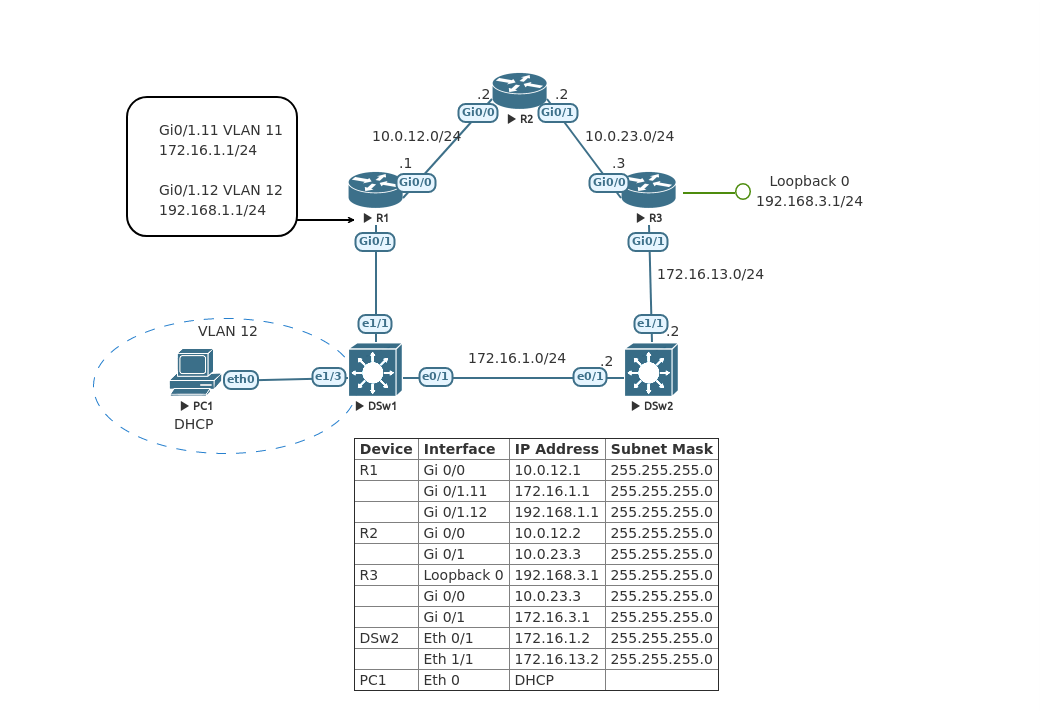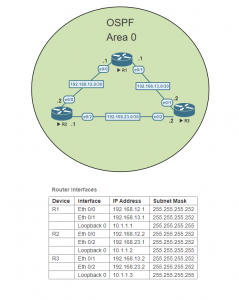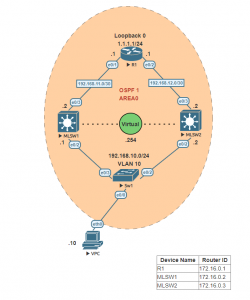Configure Router R1
Set the hostname. Create a banner. Configure the interfaces and sub-interfaces that match the table above. Create a DHCP pool for Hosts VLAN 12.
Configure Router R2
Set the hostname. Create a banner. Configure the interfaces.
Configure Router R3
Set the hostname. Create a banner. Configure the interfaces and the loopback 0 address.
Configure Switch DSw1
Set the hostname. Create a banner. Create VLANs 11 & 12. Configure its uplink port as a trunk that allows only VLANs 11 & 12. Configure port E0/1 to access VLAN 11 and configure port E1/3 to access VLAN 12.
Configure Switch DSw2
Set the hostname. Create a banner. Configure the interfaces E1/1 & E0/1 as Layer three ports with the correct IP addresses.
Configure PC PC1
Set the hostname. Using DHCP allow the PC to retrieve an IP address. Ping its gateway to verify connectivity. Save configurations.
Implement EIGRP for IPv4
Configure classic EIGRP for IPv4 on all devices. Use Autonomous System number 10, and advertise only the connected interfaces on each device. Make sure to disable auto-summarization.
R1
R2
R3
DSw2
Verify connectivity
From DSw2 ping PC1.
DSw2#ping 192.168.1.2 Type escape sequence to abort. Sending 5, 100-byte ICMP Echos to 192.168.1.2, timeout is 2 seconds: !!!!! Success rate is 100 percent (5/5), round-trip min/avg/max = 3/4/10 ms
On router R2 enter the “show ip eigrp interfaces” command.
R2#show ip eigrp interfaces
EIGRP-IPv4 Interfaces for AS(10)
Xmit Queue PeerQ Mean Pacing Time Multicast Pending
Interface Peers Un/Reliable Un/Reliable SRTT Un/Reliable Flow Timer Routes
Gi0/0 1 0/0 0/0 142 0/0 704 0
Gi0/1 1 0/0 0/0 10 0/0 50 0
Change Router R1 from Classic EIGRP to named EIGRP
Remove the router EIGRP 10 configuration from Router R1. Configure named EIGRP for IPv4 on the router. Enter into address-family configuration mode using AS 10. Configure a router-id of 1.1.1.1. Configure the network commands using wildcard bits to determine the network size.
On Router examine the EIGRP entries in the routing table, using the “show ip route eigrp | begin Gateway” command.
R1#show ip route eigrp | begin Gateway
Gateway of last resort is not set
10.0.0.0/8 is variably subnetted, 3 subnets, 2 masks
D 10.0.23.0/24 [90/15360] via 10.0.12.2, 00:08:44, GigabitEthernet0/0
172.16.0.0/16 is variably subnetted, 3 subnets, 2 masks
D 172.16.13.0/24 [90/20480] via 10.0.12.2, 00:08:44, GigabitEthernet0/0
D 192.168.3.0/24 [90/2575360] via 10.0.12.2, 00:08:44, GigabitEthernet0/0
Now examine the EIGRP topology table the all-links parameter in order to display all available routes. All though R1 has multiple ways to get to the 192.168.3.0/24 network only one gets moved to the routing table. EIGRP topology table is the EIGRP’s database of route information. EIGRP using the DUAL algorithm selects the best path to a particular network and then proceeds to add the best route to the routing table.
R1#show ip eigrp topology all-links
EIGRP-IPv4 VR(EIGRP-AS10) Topology Table for AS(10)/ID(1.1.1.1)
Codes: P - Passive, A - Active, U - Update, Q - Query, R - Reply,
r - reply Status, s - sia Status
P 192.168.3.0/24, 1 successors, FD is 329646080, serno 3
via 10.0.12.2 (329646080/328990720), GigabitEthernet0/0
via 172.16.1.2 (459407360/458752000), GigabitEthernet0/1.11
P 172.16.13.0/24, 1 successors, FD is 2621440, serno 4
via 10.0.12.2 (2621440/1966080), GigabitEthernet0/0
via 172.16.1.2 (131727360/131072000), GigabitEthernet0/1.11
P 192.168.1.0/24, 1 successors, FD is 1310720, serno 6
via Connected, GigabitEthernet0/1.12
P 172.16.1.0/24, 1 successors, FD is 1310720, serno 5
via Connected, GigabitEthernet0/1.11
P 10.0.23.0/24, 1 successors, FD is 1966080, serno 2
via 10.0.12.2 (1966080/1310720), GigabitEthernet0/0
via 172.16.1.2 (132382720/131727360), GigabitEthernet0/1.11
P 10.0.12.0/24, 1 successors, FD is 1310720, serno 1
via Connected, GigabitEthernet0/0



